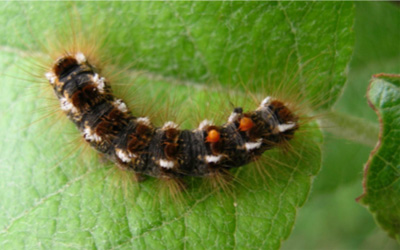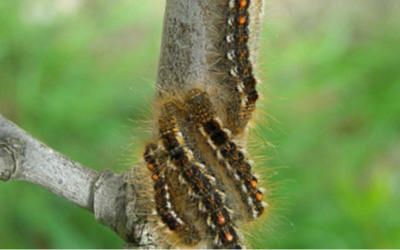DHHS → MeCDC → Disease Surveillance → Epidemiology → Vector-borne → Browntail Moths
Browntail Moths
On this page:
General Information
The browntail moth is an invasive species found only in Maine and Cape Cod. This moth is an insect of both forest and human health concern.
The browntail moth caterpillar has tiny poisonous hairs that cause dermatitis similar to poison ivy on sensitive individuals. People may develop dermatitis from direct contact with the caterpillar or indirectly from contact with airborne hairs. The hairs become airborne from either being dislodged from the living or dead caterpillar or they come from cast skins with the caterpillar molts. Most people affected by the hairs develop a localized rash that will last for a few hours up to several days but on some sensitive individuals the rash can be severe and last for several weeks. The rash results from both a chemical reaction to a toxin in the hairs and a physical irritation as the barbed hairs become embedded in the skin. Respiratory distress from inhaling the hairs can be serious.
Caterpillars are active from April to late June. Hairs remain toxic throughout the summer but get washed into the soil and are less of a problem over time.


Public Health Nuisance
Pursuant to Maine Statute Title 22, §1444 the Director of Maine CDC can declare an infestation of browntail moths (BTM) as a public health nuisance*. The declaration may be made on the Director's initiative or upon petition by municipal officers. Below is the process for declarations made upon petition by a municipality.
A. Municipalities
Should a municipality wish to petition for a public health nuisance declaration the process is as follows:
- 1. The municipality must complete the BTM Public Health Nuisance Request Form (Word) on town letterhead.
- 2. A letter from the Maine Forest Service, documenting the infestation in the town, shall accompany the Request for a BTM Public Health Nuisance Request form.
- 3. The municipality must have a letter from their local health officer supporting the request.
- 4. The municipality should submit the documentation to Infectious Disease Epidemiology, Division of Disease Surveillance, Maine CDC by mail, fax, or e-mail
- a. Mailing Address: 11 State House Station, 286 Water Street, Augusta ME, 04333-0011
- b. Fax number: 207-287-6865
- c. E-mail address: disease.reporting@maine.gov
B. Maine CDC
- 1. A copy will be made of the request upon receipt by Division of Disease Surveillance staff.
- 2. One copy will be submitted to the Director for review and signature; the second copy will be provided to the vectorborne epidemiologist, who will notify the Maine Forest Service (State Entomologist) of the request.
- 3. If approved, petitions submitted from January 1 to August 31 will expire on December 31 of the current year. Petitions submitted from September 1 to December 31 will expire on December 31 of the following year.
- 4. The form, indicating approval or denial and signed by the Maine CDC Director will be returned to the municipality via US mail.
* A public health nuisance is defined as any activity or failure to act that adversely affects public health. Examples include improperly stored solid waste such as rotting garbage or dead animals, or insect or rodent infestations.
What does a public health nuisance declaration do?
A public health nuisance declaration allows a municipality to take actions to address an issue of public health concern affecting the community. Where browntail moths are concerned, a declaration can allow the municipality to use public municipal funds on private lands to control for browntail moth populations. More specifically, a municipality may conduct aerial spray operations to target browntail moth infestations pursuant to Maine Statute Title 22, §1444. Other options may be available to control browntail moth populations and should be discussed with Maine Forest Service. A declaration can provide a municipality with more options for browntail moth treatment that may not have otherwise been available absent the declaration. A declaration does not provide access to additional state funds or services.
Resources for Maine Residents
- Frequently Asked Questions (FAQ)
- Maine DACF Browntail moth brochure (PDF)
- Maine CDC Browntail moth factsheet (PDF) | عربي | Français (PDF) | Kreyòl Ayisyen (PDF) | Lingala (PDF) | Português (PDF) | Soomaali (PDF) | Español (PDF) | Tiếng Việt (PDF)
- Maine Department of Agriculture, Conservation, and Forestry (DACF) browntail moth website

Contact 211 Maine for more information on browntail moths:
- Dial 211 (or 207-874-2211)
- Text your zip code to 898-211
- Email info@211maine.org

